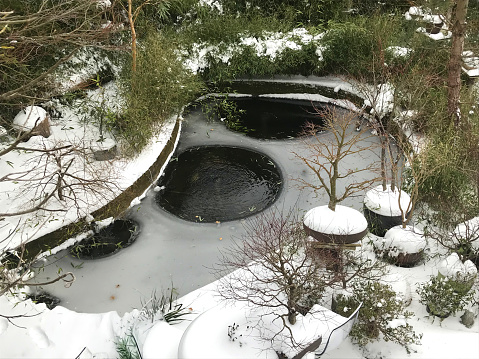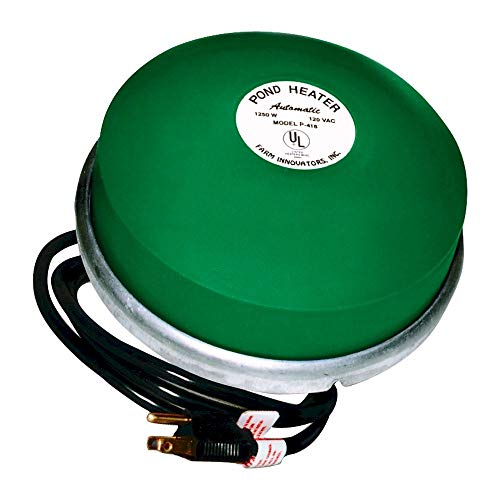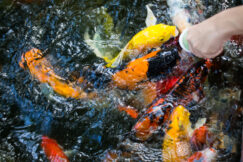Summer has come and gone. Autumn has arrived. With snow in the forecast, winter pond maintenance is immediately on your mind.
A well-stocked koi pond is an expensive investment. That is why, when the temperature decreases, effective koi pond winterization becomes critical.
You must winterize your garden pond if you live in a cold area. I’ll teach you exactly how to winterize pond fish, plants, pumps, and waterfalls in this post. In addition, I’ll walk you through the measures I take to prepare my pond for the winter.
In almost every climate, koi ponds may be enjoyed. However, if you live in a chilly winter climate, you’ll need to pick how you want your Koi to spend the winter, which is determined by two factors: your normal winter low temperatures and the depth of your pond.
Our recommendations recommend that your pond be at least 4 feet deep. If you are not planning to heat your pond all year, this is the safest depth since it gives the Koi a place to retreat for more stable temperatures.
Autumn Preparation
To guarantee the health of your Koi and the integrity of your pond, you must start in the fall. First and foremost, this entails clearing any trash from your pond. Organic matter degrades over time, reducing water quality and oxygen levels throughout the winter.
Set up pond netting
The simplest technique to contain and manage leaf management is to place a pond net over your water feature before leaves begin to fall from trees. Then, when all the leaves have fallen, roll up the net, dump the leaves, and store it until the next time it is needed.
For floating trash, use a skimmer net, and for anything else, use a pond vacuum. This is also a good time to trim and prune any aquatic plants.
It should also be noted that not all pond liners perform equally well in repeated cold conditions. For example, pre-formed PVC liners perform the poorest in harsh winter, whereas RPE liners perform the best. For additional information, see this article about how different liners perform in winter circumstances.
Winterizing aqua plants
Hardy Water Lilies may be wintered easily; clip down the withering leaves and bury the lilies to a depth where they will not freeze, generally 2 feet.
Lotus, like water lilies, may be wintered in the same way. However, Lotus will survive the winter if the tubers do not freeze solid.
Hardy plants may endure freezing temperatures as long as they remain in the pond. Among these plants are most irises, sweet flags, rushes, reeds, grasses, hibiscus, and horsetails. They can be submerged to greater depths but thrive when kept near the surface.
Marginally Hardy plants can withstand the winter cold, but they will die if their crown freezes. Pickerel plant, hardy water canna, parrot feather, water clover, water parsley, and cardinal flower are examples of these plants. These plants spend the winter submerged beneath the ice.
Outdoors, tropical plants will not survive the cold. However, if brought inside before the first frost, placed in a water container, and given enough light, many plants will flourish readily in the house. Plants like the umbrella palm, papyrus, cannas, taro, bog lily, and others can be carried indoors and used as house plants.
- Hardy waterlilies should be pruned to two inches above the crown and moved to a deep pond area, preferably two feet or more.
- Waterlilies from the tropics can be put on your compost pile. You can try to overwinter them indoors with a grow lamp, but they might not survive.
Preventative Measures and Practices
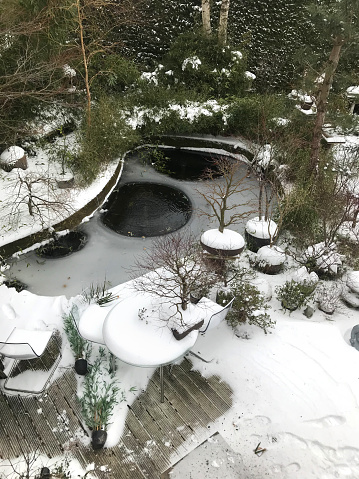
Another thing to think about as winter approaches is the health of your Koi. While most hazardous germs and parasites slow down in freezing temperatures, a koi’s immune system also slows down. As a result, a tiny issue can quickly escalate into a full-fledged calamity when the water warms up again in the spring. As the proverb goes, “An ounce of prevention is worth a pound of treatment.”
Several changes and techniques may be used to prepare your Koi for winter.
These are some examples:
Beneficial Bacteria should be included.
Cold water beneficial bacteria, such as Microbe Lift Autumn Prep or Aquascape Cold Water Bacteria, should be added.
These include helpful bacteria and enzymes that break down any lingering leaves, residual sludge, and organic waste, as well as sustain biological activity in cold water during the winter, assisting in maintaining high water quality. Maintaining appropriate water quality is key to keeping your fish healthy until spring.
Adding Pond Salt to the water is also good for the fish. It will increase the synthesis of mucous slime coats, make osmoregulation simpler, and lessen the effect of nitrite toxicity.
A 0.1 to 0.25 percent concentration is optimal (approximately 1 lb to 2 lb of salt per 100 gallons of pond water). A simple salt concentration meter may be used to determine salt concentration.
Treat Parasites and Disease
Treat your pond with Koi Prazi, Ich-X for ich treatment or a comparable product such as Terminate at roughly 50–55° F. (these are equivalents of Proform-C).
Pathogens, like Koi, will stay inactive over the winter, but when spring arrives, they will be more active than the Koi. So when your Koi are waking up in a vulnerable state, your pond must be parasite free.
To prevent potential microbial concerns, it may also be a good idea to provide medicated food with antibiotics. Feed your Koi with medicated food before winter while they can still eat. If you do, please do it before the temperature reaches 55–65 °F.
Feeding in the Fall and Winter
As previously indicated, when the temperature falls below 50°F, feeding should come to a halt. However, even before the temperature lowers, this modest feeding must be lowered depending on the water temperature.
| Water Temperature | Feeding Frequency |
| 73-80° F23-27° C | 4-5 / Day |
| 66-72° F19-22° C | 3 / Day |
| 61-65° F16-18° C | 2 / Day |
| 56-60° F13-16° C | 1 / Day |
| 50-55° F10-13° C | 1 / Week |
| <50° F<10° C | Do Not Feed |
Do Koi Fish Hibernate?
Yes, koi fish do hibernate in certain ways, and this state is known as “torpor.” During the summer, a koi’s metabolism and activity are at an all-time high. However, when the water temperature decreases, so does their metabolism. This is because Koi, like other fish, are cold-blooded.
Torpor often happens when the water temperature falls below 50° F. This is because the Koi’s basic activities, such as digestion, metabolism, and the immune system, have slowed to a crawl.
This is why, at these temperatures, you should cease feeding your Koi. During this time, they will very certainly refuse any food presented to them. In addition, any food that your Koi consumes will not be fully digested. This might cause health problems for your Koi.
Ensure that your fish are in good health before the winter arrives.
A well-balanced diet results in happy, healthy fish. You’ll want to ensure your fish are in good shape before they hibernate. When the water temperature dips below 60 degrees, your fish’s metabolism and digestion slow down.
Aquascape Premium Cold Water Fish Food Pellets have been precisely designed to appropriately nourish your fish throughout these colder months. When the water temperature goes below 50 degrees, stop feeding your fish.
- Floating pellet ideal for all size pond fish (3-inch and above)
- Probiotics aid in digestion and reduce fish waste
- Contains high-quality protein and stabilized vitamin C to promote optimal fish growth and health
Wheat germ is the key component used to improve digestion. Spirulina and healthy microorganisms are also included in the finest koi feeds. These meals should be provided when the temperature is between 55 and 65 degrees Fahrenheit.
3 Options for Koi Pond Winterization
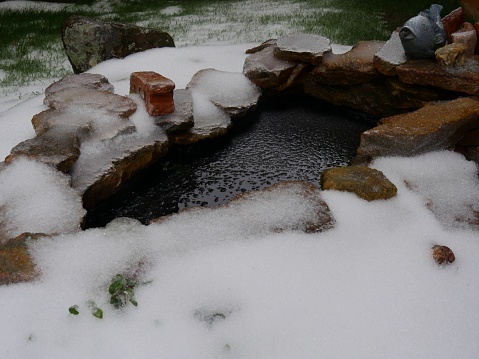
Koi fish is a robust species that can survive in extremely cold water. They’ll be alright if the water doesn’t freeze solid and there’s enough dissolved oxygen.
Many individuals successfully keep Koi outside throughout the winter, even when the pond is mostly iced over. You can even choose to keep them indoors if you choose.
Each strategy has advantages and disadvantages, and which is ideal for you depends on your scenario.
1. Bring the Koi indoors.
Moving your Koi to an indoor koi pond or holding tank is a nice alternative if you have the space.
In this manner, you can assure them they survive the winter. You can close check on your Koi if you keep them indoors. Your Koi will also continue to grow if the water is kept warm enough.
The disadvantage of this approach is that it frequently lacks room. Fully mature Koi are enormous and require a lot of space. Therefore, indoor housing may not be an option depending on the number of Koi you have and their size.
If you decide to go this way, stock tanks used for animals are a cost-effective choice. These are available in quantities ranging from around 400 gallons to a few hundred dollars. This will be an excellent location for your tank if you have a garage. Remember that if your facility isn’t climate controlled, you’ll still need a water filter and potentially a heater.
If you opt to keep your Koi indoors during the winter, you may completely shut down the pond or leave it flowing. Drain and clean any water pumps, filters, and water pipes not used.
If you opt to keep the pond running, you will still need to monitor water levels and keep an eye out for ice jams.
2. Leave your Koi in the pond without a cover.
During the winter, most people keep their Koi in an outside pond. Koi will be alright beneath a covering of ice if they are properly set up.
Pond Dimensions
First and foremost, you need a pond depth that is appropriate for your environment. Your pond should be at least 3 – 5 feet deep, depending on where you reside. The deeper you reside in an extremely cold climate, the better.
A deep pond has several advantages. The most obvious is to keep the pond water from freezing altogether. One foot or more of ice may grow in northern regions. In some situations, an 18-inch deep pond may freeze entirely. Even if the water does not entirely freeze, the Koi will have very limited space beneath the ice.
A deep pond has the additional benefit of absorbing heat energy from the ground. While the outer air temperature may be below freezing, the earth behind the frost line will be rather warm. This warmth will be transmitted to the pond, maintaining the water temperature above the surrounding air temperature.
To run your waterfall in the winter or not run it in the winter?
We recommend that you turn off your waterfall for the winter. However, leaving your waterfall running might result in some spectacular ice sculptures and sceneries.
However, if you cannot continually monitor your waterfall during freezing weather, you may see ice banks building in the stream and cascade, forcing water over the top of your liner and out of your pond.
When winterizing your waterfall, make sure to include some aeration and a floating de-icer for your fish to allow for gas exchange and the introduction of oxygen.
If your pond has a skimmer system, remove the check valve and filter material, clean them, and store them appropriately for the winter. Also, if you have a Biofalls filter, remove the filter material, clean it, and store it separately.
If you keep your pond running during winter
Operating your pond and waterfalls in the winter will offer you lovely ice formations to enjoy throughout the snowy season.
Remember that some maintenance will be necessary this time of year, such as topping off the pond due to evaporation. You’ll also want to ensure that ice forms don’t build dams that cause needless water loss over the stream’s edge.
Even with the waterfall running, the surface of your pond may ice over during extreme cold spells.
Use an aerator or an in-pond pump to keep a hole in the ice. In extremely cold weather, you may need to add a pond de-icer, but usually, an aerator will suffice.
Warmer regions may leave water pumps, filters, and other systems operating all winter. If these are at risk of freezing, they should be suitably insulated or turned off and emptied.
Because the fish produce relatively little waste in their torpor state, it is often safe to turn off the filtering equipment during winter.
If there is a risk of freezing, you should install an air pump with a bubbler. While Koi are alright under ice, they require a little opening in the ice. An air stone will help oxygenate the pond while maintaining a hole in the ice for gas exchange.
This bubbler should be installed at a depth of 10-12 inches below the water’s surface. It will not disrupt the warmer water below at this depth.
If the water entirely freezes over, do not attempt to break through the ice. Fish feels shock waves and vibrations. Instead, if the ice is thin enough, set it on top of a kettle of hot water. An electric drill may be used to cut through thick ice.
In really cold temperatures, you may additionally want a floating de-icer to keep a hole in the ice open.
- Thermostatically Controlled Pond De-Icer Maintains A Vent Hole In The Ice To Allow Harmful Gasses To Escape
- Constructed Of Patented Cast Aluminum For Ultimate Efficiency And Safety
- Fish and plant-friendly heater is for use in ponds of 50 to 600 gallons
Waterfalls need special care. While they may not freeze in some areas, they can have a detrimental impact on water temperature. This is because waterfalls cycle the water, so it is always in contact with the air.
This implies that the waterfall will fast warm the water on hot days, and the waterfall will rapidly cool the water on cold days. This temperature swing will stress the Koi and may result in health issues.
When Should You Install A Pond De-icer (Heater)? Before the water in the pond freezes over.
One of the most critical measures in successfully winterizing a pond is to keep a breathing hole available in the pond ice. A hole enables gas exchange, enabling hazardous gases like CO2 to exit and oxygen to dissolve from the air.
Even if you’ve cleaned up a large pond, there will certainly be some garbage. However, Koi will continue generating garbage much slower over the winter.
Even a tiny quantity of ammonia build-up can badly stress your Koi without a proper method of gas escape. Thus we must maintain a hole open throughout winter to prevent this danger.
Installing a floating pond de-icer before the pond water freezes over is the simplest method to accomplish this. The heater will float on the surface water and slightly warm its surroundings, allowing a continual hole in the ice to remain open. Koi will also like the slightly warmer temperature, and you’ll notice them clutching the heater and occasionally coming out for air.
3. Use a cover to keep your Koi in the pond.
You may cover your fish’s outside pond to provide them with more security. There are other methods for accomplishing this, but they all serve the same purpose: to retain heat and avoid freezing.
Simply placing some pipes or timber across the pond and covering it with a solar cover will suffice as a pond cover. Or, my personal favorite, you may construct a greenhouse on top of your pond. You may enjoy your koi pond all year round this way.
Consider the possible snow load while selecting a cover choice. Can your snow cover withstand the weight of the snow? If the structural stability of the cover is in doubt, you may need to clean it immediately after each snowfall.
You may want to keep filters, pumps, and water features running depending on how warm your pond stays. Instead of an open koi pond, a covered koi pond will most likely remain unfrozen.
You can even use a water heater without significantly increasing your power cost. As a result, your Koi will be active and thriving all year. However, if your water temperature remains over 50° F, you must continue feeding to sustain this development. This also implies that your fish will produce waste, necessitating the need for the pond’s filtering equipment.
Keeping your fish safe from predators in the winter
Even if the winter season has arrived and your pond is completely coated in ice (save for the hole from your aeration/de-icer! ), your fish can still be preyed upon.
Adding a dark pond dye weekly throughout the winter makes it difficult for predators to detect your fish resting on the pond bottom.
Conclusion
I hope this provides some ideas and possibilities for your koi fish during winter. Plan ahead of time for how you intend to overwinter your koi pond.
Last update on 2022-09-11 / Affiliate links / Images from Amazon Product Advertising API

